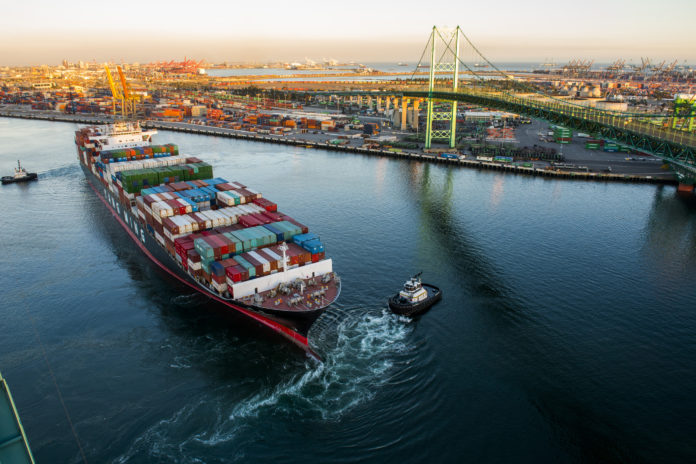The Port of Los Angeles handled 961,833 twenty-foot-equivalent units of cargo in August, beating out its previous volume record set in October 2018, and 12% more than in August 2019.
Imports increased year over year by 18% to 516,286 TEUs, exports were down 10.2% to 131,429 TEUs, and the volume of empty containers was up 13.3% to 314,118 TEUs.
Terminal operators and dockworkers at the Port of Long Beach moved 725,610 TEUs of cargo last month, a 9.3% increase compared to same period last year.
Imports rose 13% to 364,792 TEUs while exports grew 1% to 126,177 TEUs. The volume of empty containers shipped overseas increased 8.5% to 234,642 TEUs.
“This is the first time in our history that we’ve ever crossed the half-million mark on imports,” Port of Los Angeles Executive Director Gene Seroka said during a video press conference. “However, imports are still down year to date through August by almost 8%.”
Both ports attributed the increases to unscheduled sailings — Port of Long Beach picked up 10 extra vessels while its sister port handled seven, for a total of 90 and 89, respectively.
“We’re seeing both replenishment of warehouse and distribution center inventories along with retailers prepping for year-end holidays,” Seroka said. “We built up some inventory during pre-tariff milestones, and that has been predominantly worked out, and now we’re restocking that inventory.”
Seroka said the rest of the peak season, which runs from August to October, looks promising. Based on the weekly data his team gathered and shares via the port’s Signal platform, the cargo volume for September is on track to surpass the 900,000 TEUs milestone.
“If achieved, that would be the first time a U.S. port has reached 900,000 TEUs in consecutive months ever,” Seroka said, adding that he now anticipates the total cargo volume for this year will be about 8.5 million TEUs or about 9% less than last year. In May, he forecast 2020 volume at 7.9 million TEUs, which would equate to a 15% year-over-year decline.
“With all of this, a word of caution — one month or even one quarter does not make a trend,” Seroka said. “Despite this import surge that we’re seeing, the U.S. economy and global trade face significant challenges. Cargo volume remains down nearly 12% year-on-year through August. The trade imbalance has deepened, with American exports continuing to struggle. In my view, our economy remains in a very precarious position.”
The Port of Long Beach has moved 4,911,725 TEUs during the first eight months of 2020, down 1.2% from the same period in 2019. Executive Director Mario Cordero, shares Seroka’s cautious stance.
“August marked another great month for the port, but we must remain vigilant about the global pandemic’s lasting effects,” he said in a statement.
Jonathan Gold, vice president of supply chain and customs policy at the National Retail Federation, joined Seroka for the press conference, and said that the surge in cargo volume reflects retailers’ attempt to meet the anticipated demand, but also not “over order and put themselves in a position where if we do have a shutdown again that impacts retail sales.”
“We’ve seen consumers have a little more disposable income now because they’re not doing the traveling and going out,” Gold said. “Obviously, there’s still high unemployment (and) Congress needs to get back and do the work and pass another Covid-related relief bill to help with some of those unemployment benefits that have unfortunately stopped. But I think we are seeing consumers spend on some of the holidays … and back to school was a surprisingly a good season.”
Gold and Seroka also addressed bottlenecks and other operational issues related to truck chassis availability, which can escalate when imports and exports are out of balance.
Port of Los Angeles is tracking “five imports for every one export container, where we had been at about three to one, or seven to two,” Seroka said.
“We are seeing imports increase, exports wane, and a widening of the supply chain trade gap in pure container format, much less the dollar value that trade people in Washington have to worry about,” he added.
Seroka urged stakeholders to use the port’s cargo data platforms to better plan their day-to-day operations.
He also brought up the Pool of Pools, a sharing agreement between the three major marine container chassis pools operating in the San Pedro Basin port complex, which includes a fleet of more than 62,300 marine container chassis serving 11 terminals and four rail facilities.
The Pool of Pools accounts for about 65% of the haulage at the port complex, with the balance being trucker-owned and long-term lease chassis.
The ports usually plan for chassis from Pool of Pools being out of port for about four days to deliver containers to warehouses or to the customer’s facility. But pandemic-related staffing issues at warehouses in the Inland Empire and other areas have caused delays.
“We’re starting to see dwell times inch up, and we need to inject additional chassis to get that right sized,” Seroka said.

